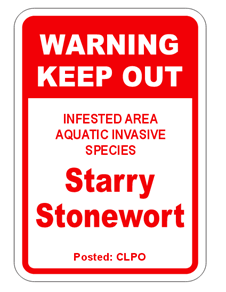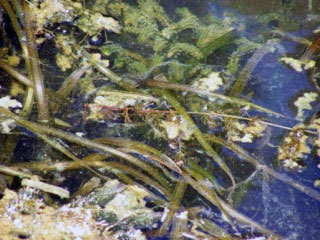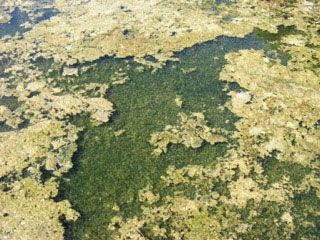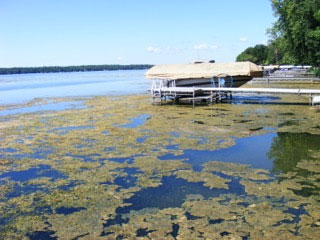Starry Stonewort
 Starry stonewort is a grass-like form of algae that are not native to North America. It typically grows an inch a day in height and width. It does not go dormant and continues to grow in the winter-time. You can't swim, fish or boat in it and it is poisonous to animals. To date, no lake has been able to eradicate it, which is why they call it a "lake killer". Starry stonewort is a grass-like form of algae that are not native to North America. It typically grows an inch a day in height and width. It does not go dormant and continues to grow in the winter-time. You can't swim, fish or boat in it and it is poisonous to animals. To date, no lake has been able to eradicate it, which is why they call it a "lake killer". The plant was first confirmed in Minnesota in Lake Koronis (Stearns County) in late August of 2015. Plant fragments were probably brought into the state on a trailered watercraft from infested waters in another state. Other lakes in MN have since discovered Starry Stonewort, with one of them being Lake Sylvia, Rice Lake and Grand Lake. So, we now have four lakes very close to us that are now infected with Starry Stonewort: Lake Sylvia, Rice Lake, Grand Lake & Lake Koronis. How to identify Starry Stonewort Starry Stonewort is similar in appearance to native grass-like algae such as other stoneworts and musk-grass, which are commonly found in MN waters. Starry Stonewort can be distinguished from other grass-like algae by the presence of star-shaped bulbils. Starry Stonewort Fact Sheet Follow this link to view a brief but excellent description of the differences between Starry Stonewort and some of our native species. Useful Video to Identify Starry Stonewort Here's another great video from YouTube on identifying Starry Stonewort. Chara looks a lot like Starry Stonewort. Click Here for a fact sheet on how to compare the two. ** If you suspect you have found Starry Stonewort or any other invasive species, note the exact location, don't disturb the area, take a photo or keep the specimen and contact the DNR & CLPO. Early detection is key!!! Why is Starry Stonewort a problem? Starry Stonewort can interfere with recreational and other uses of the lake by producing dense mats at the waters surface. Boats are not able to get through these dense mats. It may displace native aquatic plants and choke out fish spawning beds. How does it spread? Starry Stonewort is believed to be spread from one body of water to another by unintentional transfer of plant fragments and bulbils, the star-like structures produced by the plant. The fragments, or mud containing the fragments, can be transferred on trailered boats, personal watercraft, docks, boat lifts, anchors or any other water-related equipment that has not been properly cleaned. What can people do to prevent its spread? The most important action you can do to prevent the spread of Starry Stonewort is to Clean, Drain, Dispose, which is required by law in MN. Clean all vegetation, animals, mud & debris from your watercraft and any water-related equipment before moving it from one body of water to another. Drain all water from your watercraft and bait bucket(s), including lowering the lower unit once you're out of the water to allow the water to drain before installing the transom saver bar and keep the drain plugs out during transport. Dispose of any unwanted bait in the trash. Right now there are no laws limiting access to Starry Stonewort infected waters, but keeping water related equipment out of the infected lakes right now while they are trying to find a treatment would be the safest. What can be done to reduce Starry Stonewort? There has not been much success in reducing or eliminating it. It appears that treatment with herbicides can suppress it. Some states use hand pulling to reduce biomass in small areas. Mechanical removal can also be effective, but not recommended in newly discovered lakes that have limited distribution in the lake. Mechanical harvesting might create fragments that would spped up the spread of the invasive plant within the lake. Clearwater Lake - Starry Stonewort Early Detection Search Unfortunately on Monday, August 21, 2023, Starry Stonewort has been found growing in Clearwater Lake by Steve McComas of Blue Water Science while conducting our 2023 point intercept survey. Clearwater Lake becomes the 26th lake in the state to be infested and only the second lake where it was not found by a boat landing. An estimated 1.8 acres of Starry Stonewort growth was found in an isolated bay and because of its location, went undetected for perphaps 2-3 years. Thankfully the point intercept survey found it. The area of infestation is in the East Basin and will be marked by a perimeter of signs with red lights. They will have to be taken out before winter & put back in the spring. It's EXTREMELY important that everyone stays far away from that area.
There is room for some optimism in that thhe area of growth is confined and considered, much to our benefit an early detection. Early detection has historically been the key to successful control of Starry Stonewort. The CLPO's AIS plan has been effective in its design and implementation and will continue to be aggressively applied as we move forward.  2023 Clearwater SSW Searches Report 2023 Clearwater SSW Discovery Aug. 21, 2023 Report 2023 SSW Search Sites 2022 Clearwater SSW Search Report 2021 Clearwater SSW Search Report 2020 Clearwater SSW Search Report Early Detection Report from Jan. 2020 Early Detection Report from 4-8-17 On Aug 2nd & Oct. 9th, 2017, we had Blue Water Science come out and search for Starry Stonewort at the Bob's Bay landing area, Hwy 24 and the Black Pool landing area. They did not detect any Starry Stonewort. Below are two videos they took of the underwater view. Video 1 Video 2 SSW Search Report 8-2-17 & 10-9-17 Good news for Clearwater Lake from the Starry Trek event held on August 5th. A potential AIS sample collected near the Black Pool DNR access ramp was found to be native and not Starry Stonewort. Unfortunately for another lake in our region the news was not so good. A sample collected from Grand Lake was confirmed to be Starry Stonewort, thus adding yet another Minnesota lake to the infested category. This is a good reminder that we all need to be vigilant - when we move boats (and docks) from lake to lake we need to ensure that we Clean, Drain, and Dry our boats and trailers. This isn’t just a slogan on a sign, it’s what we need to do every time. Please watch the AIS Video below, which shows how fast and destructive it is to a lake. AIS Video - Above and Below the Waterline Currently the MN DNR is doing nothing to stop the spread of Starry Stonewort. We are also asking you to please write your legislature to have them help stop the spread of it. How to write your legislature to help stop the spread of Starry Stonewort Powerpoint Presentation from the WI DNR 6-5-19 Progress in Controlling Starry Stonewort 4-22-17 Starry Stonewort Summit Summary 4-22-17 Starry Stonewort Summit Presentation - Dr. Rodgers Additional info from the Univ of MN Starry Stonewort Watch Card |
||||||
|
||||||
 Starry stonewort is a grass-like form of algae that are not native to North America. It typically grows an inch a day in height and width. It does not go dormant and continues to grow in the winter-time. You can't swim, fish or boat in it and it is poisonous to animals. To date, no lake has been able to eradicate it, which is why they call it a "lake killer". Starry stonewort is a grass-like form of algae that are not native to North America. It typically grows an inch a day in height and width. It does not go dormant and continues to grow in the winter-time. You can't swim, fish or boat in it and it is poisonous to animals. To date, no lake has been able to eradicate it, which is why they call it a "lake killer". The plant was first confirmed in Minnesota in Lake Koronis (Stearns County) in late August of 2015. Plant fragments were probably brought into the state on a trailered watercraft from infested waters in another state. Other lakes in MN have since discovered Starry Stonewort, with one of them being Lake Sylvia, Rice Lake and Grand Lake. So, we now have four lakes very close to us that are now infected with Starry Stonewort: Lake Sylvia, Rice Lake, Grand Lake & Lake Koronis. How to identify Starry Stonewort Starry Stonewort is similar in appearance to native grass-like algae such as other stoneworts and musk-grass, which are commonly found in MN waters. Starry Stonewort can be distinguished from other grass-like algae by the presence of star-shaped bulbils. Starry Stonewort Fact Sheet Follow this link to view a brief but excellent description of the differences between Starry Stonewort and some of our native species. Useful Video to Identify Starry Stonewort Here's another great video from YouTube on identifying Starry Stonewort. Chara looks a lot like Starry Stonewort. Click Here for a fact sheet on how to compare the two. ** If you suspect you have found Starry Stonewort or any other invasive species, note the exact location, don't disturb the area, take a photo or keep the specimen and contact the DNR & CLPO. Early detection is key!!! Why is Starry Stonewort a problem? Starry Stonewort can interfere with recreational and other uses of the lake by producing dense mats at the waters surface. Boats are not able to get through these dense mats. It may displace native aquatic plants and choke out fish spawning beds. How does it spread? Starry Stonewort is believed to be spread from one body of water to another by unintentional transfer of plant fragments and bulbils, the star-like structures produced by the plant. The fragments, or mud containing the fragments, can be transferred on trailered boats, personal watercraft, docks, boat lifts, anchors or any other water-related equipment that has not been properly cleaned. What can people do to prevent its spread? The most important action you can do to prevent the spread of Starry Stonewort is to Clean, Drain, Dispose, which is required by law in MN. Clean all vegetation, animals, mud & debris from your watercraft and any water-related equipment before moving it from one body of water to another. Drain all water from your watercraft and bait bucket(s), including lowering the lower unit once you're out of the water to allow the water to drain before installing the transom saver bar and keep the drain plugs out during transport. Dispose of any unwanted bait in the trash. Right now there are no laws limiting access to Starry Stonewort infected waters, but keeping water related equipment out of the infected lakes right now while they are trying to find a treatment would be the safest. What can be done to reduce Starry Stonewort? There has not been much success in reducing or eliminating it. It appears that treatment with herbicides can suppress it. Some states use hand pulling to reduce biomass in small areas. Mechanical removal can also be effective, but not recommended in newly discovered lakes that have limited distribution in the lake. Mechanical harvesting might create fragments that would spped up the spread of the invasive plant within the lake. Clearwater Lake - Starry Stonewort Early Detection Search Unfortunately on Monday, August 21, 2023, Starry Stonewort has been found growing in Clearwater Lake by Steve McComas of Blue Water Science while conducting our 2023 point intercept survey. Clearwater Lake becomes the 26th lake in the state to be infested and only the second lake where it was not found by a boat landing. An estimated 1.8 acres of Starry Stonewort growth was found in an isolated bay and because of its location, went undetected for perphaps 2-3 years. Thankfully the point intercept survey found it. The area of infestation is in the East Basin and will be marked by a perimeter of signs with red lights. They will have to be taken out before winter & put back in the spring. It's EXTREMELY important that everyone stays far away from that area.
We are planning on 2-3 chemical treatments in 2023, followed by ongoing assessments and treatments in years to follow. Given the amount of growth, hand pulling is not practical and more aggressive harvesting with machines is not recommended because of greater risk for spread. There is room for some optimism in that thhe area of growth is confined and considered, much to our benefit an early detection. Early detection has historically been the key to successful control of Starry Stonewort. The CLPO's AIS plan has been effective in its design and implementation and will continue to be aggressively applied as we move forward.  2023 Clearwater SSW Searches Report 2023 Clearwater Discovery Aug. 21, 2023 Report 2023 SSW Search Sites 2022 Clearwater SSW Search Report 2021 Clearwater SSW Search Report 2020 Clearwater SSW Search Report Early Detection Report from Jan. 2020 Early Detection Report from 4-8-17 On Aug 2nd & Oct. 9th, 2017, we had Blue Water Science come out and search for Starry Stonewort at the Bob's Bay landing area, Hwy 24 and the Black Pool landing area. They did not detect any Starry Stonewort. Below are two videos they took of the underwater view. Video 1 Video 2 SSW Search Report 8-2-17 & 10-9-17 Good news for Clearwater Lake from the Starry Trek event held on August 5th. A potential AIS sample collected near the Black Pool DNR access ramp was found to be native and not Starry Stonewort. Unfortunately for another lake in our region the news was not so good. A sample collected from Grand Lake was confirmed to be Starry Stonewort, thus adding yet another Minnesota lake to the infested category. This is a good reminder that we all need to be vigilant - when we move boats (and docks) from lake to lake we need to ensure that we Clean, Drain, and Dry our boats and trailers. This isn’t just a slogan on a sign, it’s what we need to do every time. Please watch the AIS Video below, which shows how fast and destructive it is to a lake. AIS Video - Above and Below the Waterline Currently the MN DNR is doing nothing to stop the spread of Starry Stonewort. We are also asking you to please write your legislature to have them help stop the spread of it. How to write your legislature to help stop the spread of Starry Stonewort Powerpoint Presentation from the WI DNR 6-5-19 Progress in Controlling Starry Stonewort 4-22-17 Starry Stonewort Summit Summary 4-22-17 Starry Stonewort Summit Presentation - Dr. Rodgers Additional info from the Univ of MN Starry Stonewort Watch Card |
||||||
|
||||||










